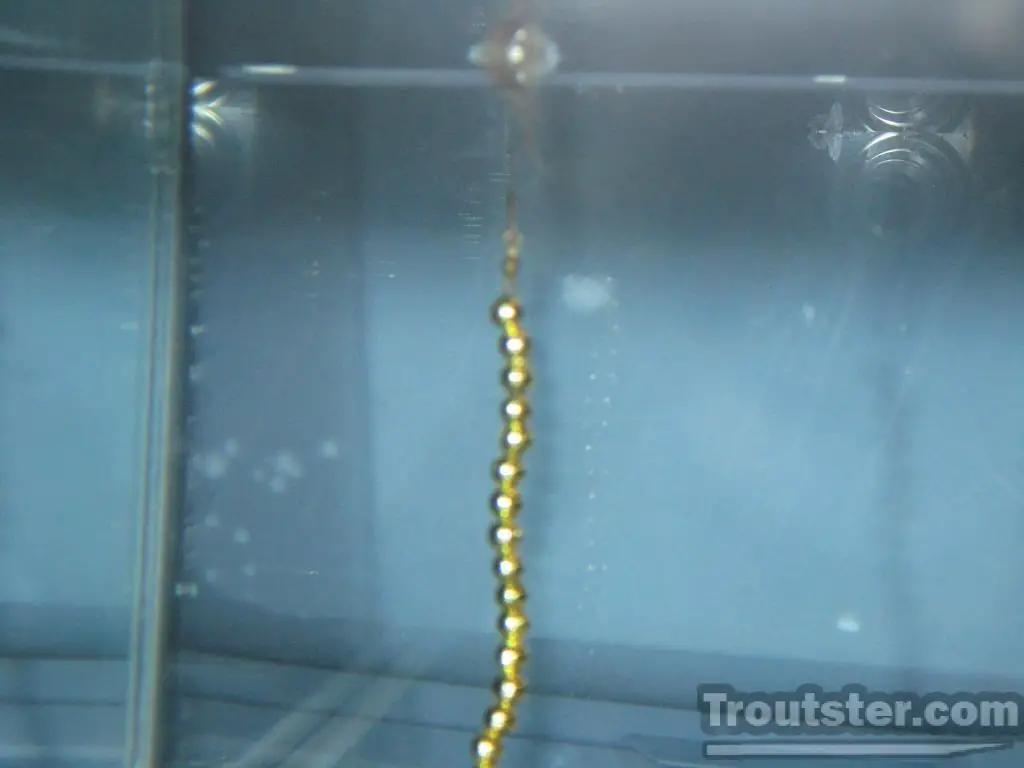This post was last updated on August 6th, 2021 at 06:12 pm
A Test/Review of Several of the Top Floatants
 I will start by giving you an overview of what I hope to accomplish with this post, so if you wish you can get an idea of what is going to take place and then skip to the results.
I will start by giving you an overview of what I hope to accomplish with this post, so if you wish you can get an idea of what is going to take place and then skip to the results.
The Testing Procedure
I will be putting a huge lineup of fly floatants through various tests to determine what type will float your flies best. Are some of the floatants that cost 2x and even 3x the price of inexpensive competitor products worth the price? Will they in fact make your flies float better and longer? Or will they just cost more and deliver similar floating ability. Keep in mind that I do not work for any of the companies who make these products, nor am I being paid by any of them.
What tests will we use?
The short answer is we are going to run these floatants through the mill!
We will test the following properties of these products
- Their ability to continue to float after being subjected to “fish slime” (which we all know destroys a flies ability to float.)
- We will determine how much weight our flies can hold up using all of these different products, think “hopper dropper rig“
- We will try to measure the amount of “oil slick” on the surface of the water from each type of floatant
- Also taken into consideration will be how easy is this particular product to apply and what type of effect do extreme temperatures have on its consistency and viscosity.
My original plan included a test of how long a fly will float using each product in completely still water, however they all stay up for a very long time. It turned out to be a very time consuming test to measure. I also began testing using humpy flies. I decided that these flies could have different levels of buoyancy, due to possibly different amounts of deer hair on the base of each individual fly. I opted for a fly without any deer hair (or any heavily floating hair on the body)for the test, the parachute Adams.
The Results
I spent a lot of money on every floatant I could find at Amazon, the floatants included in the test are:
- Gehrkes Gink
- Loon Aquel
- Mucilin (non silicone red can)
- Mucilin silicone liquid
- Loon Lochsa
- Umpqua Bug Flote
- Umpqua Dry Magic
- Fly-Agra
- Umpqua Shimazaki
- Frogs Fanny
The First Set of Test Results:
I put each fly (color coded) into an individual cup of water. The liquids (Liquid Mucilin and Fly Agra) were the first to go down after vigorous shaking in this test. After 18 minutes of violent churning water, all of the gels had sunk, however the final 2 products that proved to be unsinkable by my churning water test were the powders (Frogs fanny and Shimazake Dry shake). These powder floatants would have possibly had different outcomes after a few false casts and some of the powder being shaken off in the air. I don’t know the answer to that question yet, but I plan to find out before this test is completed by using an air compressor on each tested fly.
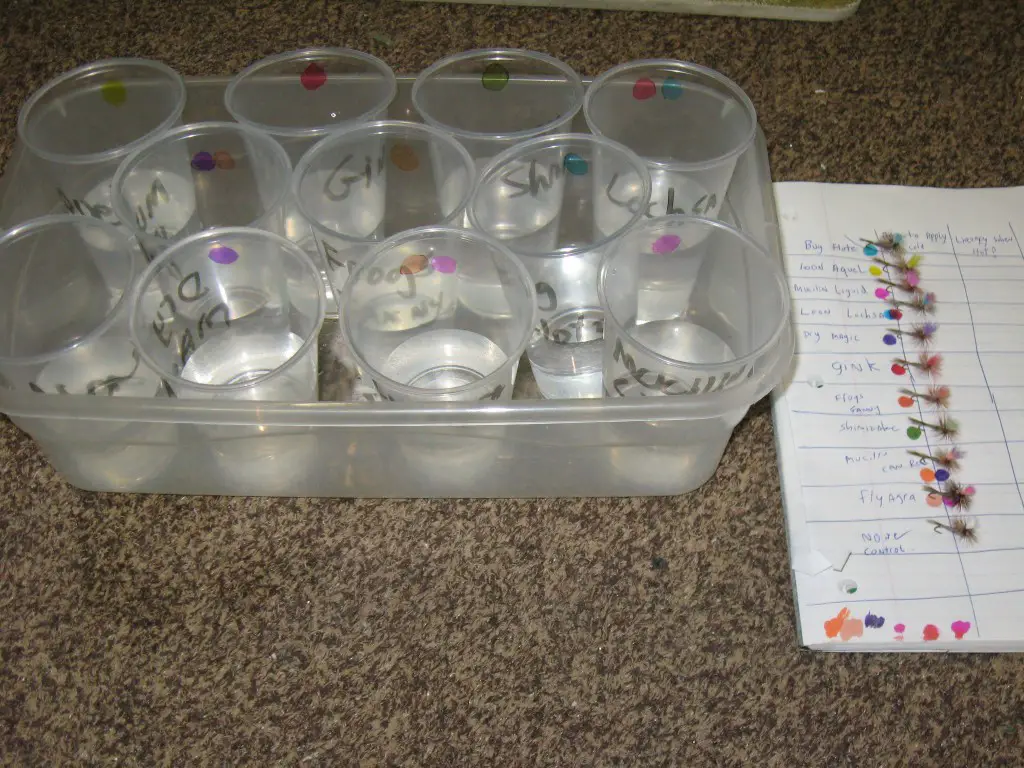
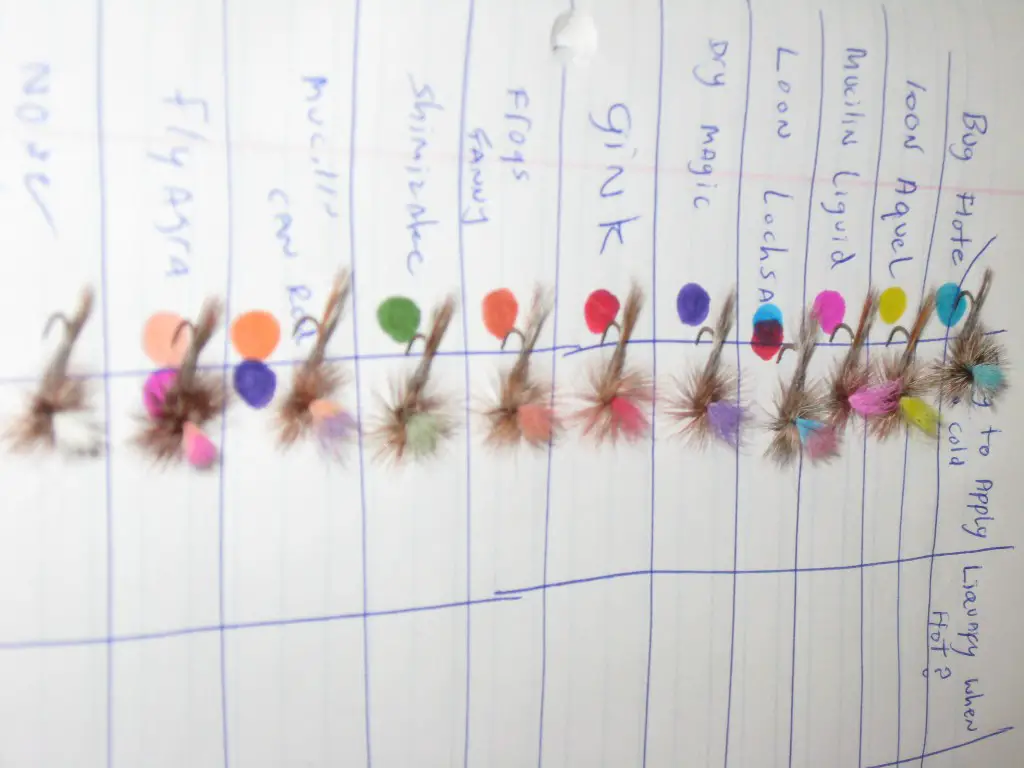
The Bead Test – Fly Floatant Reviews
This Determines How Much Weight Each Fly and Floatant Could Hold Up
I used a swivel with 4x monofilament tippet to figure out how much weight each fly could hold up. Threaded onto this monofilment was a series of plastic beads. We got some pretty amazing results. Our fly floatants and test flies were able to hold up between 13 and 23 beads. The major standout winner of this test was the Shimazake dry shake blowing away all competition with 23 beads! The nearest competitor was Loon Lochsa with 18 beads. Our control fly (the fly with no fly floatant applied) was able to hold up 13 beads, but I had to switch to a new fly each time it sunk. Once it was submerged it became saturated and could not hold even a small amount of beads above water.
The Fish Slime Exposure Test
At my local bait shop I was able to obtain a bag full of dead frozen minnows. I thawed this mixture of various shiner species, added a little water and sloshed it around in a bag. I was able to get some really dense fish slime to expose our test subjects to.
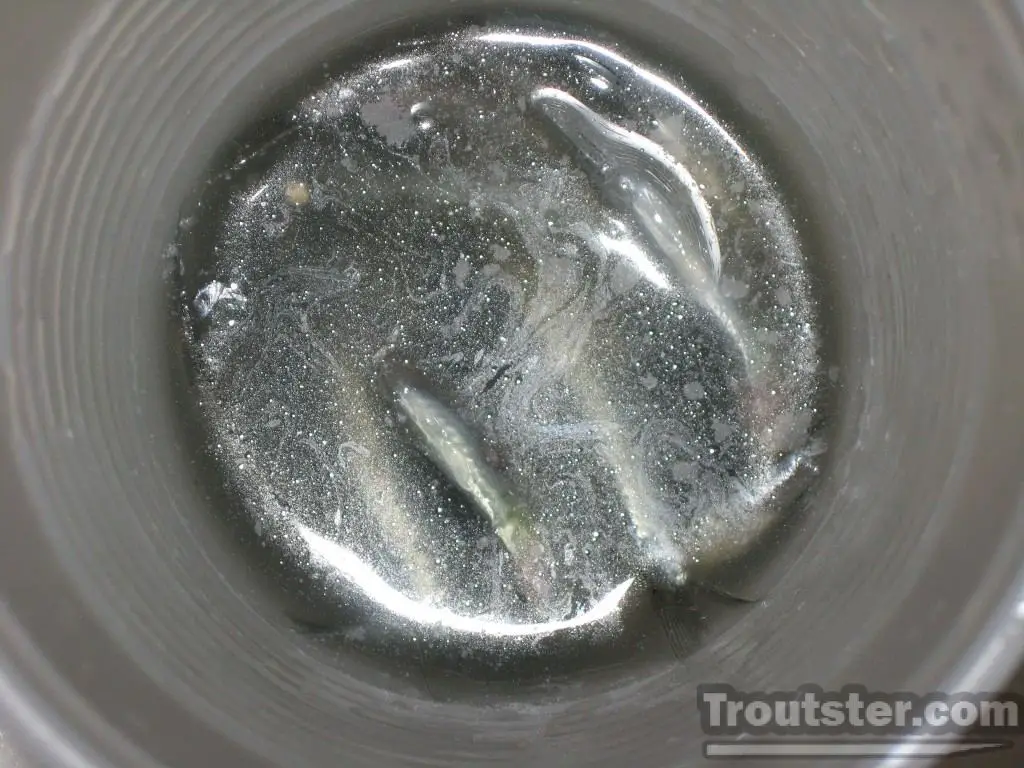
The Fly Floatant VS Fish Slime Testing Procedure:
Each fly was gripped by the hook and dipped into the fish slime mixture. It was then tapped 7 times on the edge of the cup to remove some of the slime and dropped from a measured distance above my fish tank test area. All of the liquid and gel floatants sunk after this experiment, but the Frogs fanny and Shimazake dry shake were able to withstand the slime and continue floating as though they were never exposed.
I then put on a fresh coating of the powder fly floatants and subjected them to 10 seconds of an air compressor; blowing off most of the visible product. I re-dipped them in the slime and dropped them from the same position I had previously and they both sunk very slowly. They still performed better than any other tested products. They were very close to floating and both had visible air pockets within the hairs of the fly.
Fish Slime Test #2 (As shown in the results below)
I re-tested all of the flies by dipping them entirely into the cup of fish slime and blowing off the excess slime and water with 5 seconds of a 10 psi air blast to simulate false casting. I then dropped the flies from 32″ inches (or 81.28 centimeters), multiple times to determine how many drops each fly could handle before sinking. I stopped the test for each individual after 30 drops.
The Churning Water Tank Test
This test consisted of a 10 gallon tank with an air compressor in one corner at 40 psi. This caused a violent agitation to the water which most fly floatants could not handle. The 2 stand out winners were the same as in all of the previous tests: the powders. Shimazake dry shake blew away all competition again with survival in the churning water for 3 minutes with no signs of sinking in sight. In second place was Frogs fanny at 1 min. 57 seconds. A surprise 3rd place finish was Loon Aquel with an 18 second survival time. All of the other tested fly floatants were in a tight group with an average of 6 seconds afloat in the tank.
Our control fly with no floatant applied to it had a survival time of 8 seconds in our first test. That’s higher than many other fly floatants, however once this fly did sink, it became saturated and would not float even 1 second in our churn tank without some time to dry out.
The Fly Floatants |
Cost of each product | Amount of time floating in the churn and burn tank. | Does this product create an oil slick on the water? | How many consecutive drops from 32″ could this fly and floatant stay above water after fish slime exposure. | Is this product affected by heat and cold? | How Much weight can this fly and floatant hold up? |
|---|---|---|---|---|---|---|
Umpqua Bug Flote (Gel) 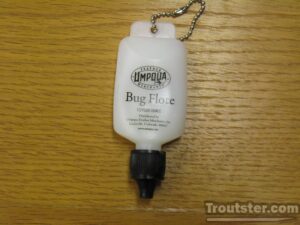
Test Summary: This product scored average in most tests. It showed that in extreme temps even 60 degrees it can become hard to dispense. It was not able to hold up much weight and showed a low-decent resistance to fish slime. |
Cost: $5.45 – 3.98 Euro | 6 seconds | NO | (5)This fly sunk on drop #6 | YES, Turns to liquid when exposed to high heat, it also became unusable in extreme cold. | 13 beads |
Loon Aquel (Gel) 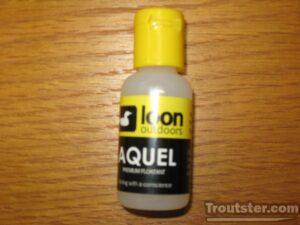
Aquel floatant was not able to hold a lot of weight, however it showed extremely good resistance to fish slime. Its performance in the rough water test showed it to stay afloat longer than any other gel or liquid fly floatant tested. Everything taken into consideration, this is a good product for the money. |
Cost: $5.45 – 3.98 Euro | 18 seconds | NO | 30+ | NO, Aquel was not affected by extreme heat or cold temps. | 13 beads |
Mucilin Silicone (Liquid)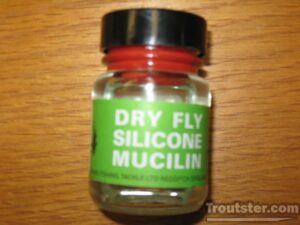 Mucilin silicone liquid floatant was not able to hold a lot of weight in our tests. It showed a low resistance to fish slime and an average performance in our rough water test. As with both tested liquids it is a pain to apply and has a strong odor. Mucilin silicone liquid floatant was not able to hold a lot of weight in our tests. It showed a low resistance to fish slime and an average performance in our rough water test. As with both tested liquids it is a pain to apply and has a strong odor. |
Cost: $7.15 – 5.22 Euro | 6 seconds | YES | (3)This fly sunk on drop #4 | NO, Not affected by high heat or cold | 14 beads |
Loon Lochsa (Gel)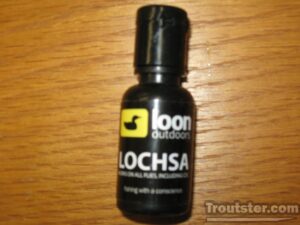
Lochsa was able to hold a great amount of weight. It showed a great resistance to fish slime and had an average performance in the rough water test. |
Cost: $9.45 – 6.89 Euro | 6 seconds | NO | 30+ | NO, Loon Lochsa had a consistent viscosity in extreme hot and cold temperatures | 18 beads |
Umpqua Dry Magic (Gel)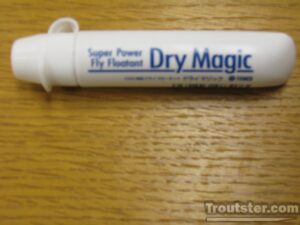
Dry magic was not able to hold much weight up. It had an average performance in the rough water test and showed a pretty good resistance to fish slime. It is expensive but has a nice bottle and dispenses well in all temps. |
Cost: $13.20 – 9.63 Euro | 6 seconds | NO | (29)This fly sunk on drop #30 | NO, Dry Magic was not affected by high heat or extreme cold | 12 beads |
Gehrke’s Gink (Gel)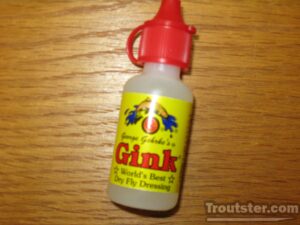
Gink was able to hold up a pretty good amount of weight. It showed a low resistance to fish slime. It had an average performance in the rough water test. It had a poor showing in the extreme temperature test. |
Cost: $5.50 – 4.01 Euro | 6 seconds | NO | (6)This fly sunk on drop #7 | YES, This product turned to liquid when exposed to high temperature. It also became hard to dispense in very cold temperatures. | 17 beads |
Frogs Fanny (Powder)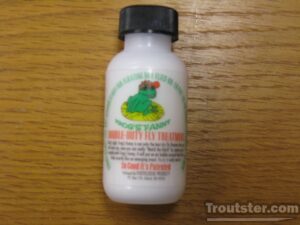
Frogs Fanny powder floatant was able to hold up weight pretty well in our bead test. It had no trouble resisting fish slime and did really well in our rough water test. I did manage to use almost half a bottle during testing. It will go quickly when applied as the instructions say. It is kind of a pain to use, but it had a really good showing in our tests. |
Cost: $6.05 – 4.41 Euro | 1 min 57 seconds | NO | 30+ | NO, Not affected by high heat or cold temps. | 16 beads |
Umpqua Shimazake Dry Shake (Powder)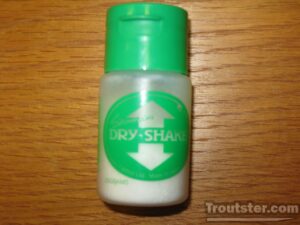
Shimazake floatant scored the highest in every test I put it through. It held the most weight, showed an amazing resistance to fish slime and was unsinkable in our rough water test. When used as instructed it will last a long time and is easy to apply. At $11.55 this floatant is a bargain. I can honestly say I had only used this a couple times until I tested it. This floatant will have a permanent place in my gear bag. |
Cost: $11.55 – 8.42 Euro | over 3 minutes | NO | 30+ | NO, Not affected by high heat or cold | 23 beads |
Mucilin Red Can Silicone free (Paste)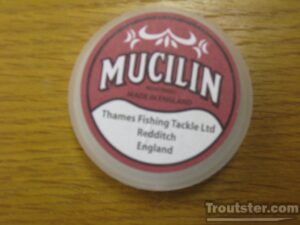
The red can of mucilin was able to hold a decent amount of weight. It is tough to use when it gets hot. It did fare pretty good in our rough water test. Overall a decent showing from silicone free muclilin. If you plan to catch a lot of fish you can expect to apply this product after each one. It scored the lowest of all tested in our fish slime resistance test. |
Cost: $5.35 – 3.90 Euro | 8 seconds | NO | (2)This fly sunk on drop #3 | YES, Mucilin will become liquid in high temperatures, it also became quite firm but still useable in extremely cold temperatures. | 16 beads |
Fly-Agra (Liquid)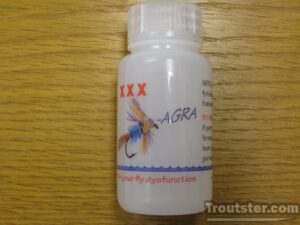 Fly-Agra held up a decent amount of weight, and showed a fair resistance to fish slime. It scored average in the rough water test. Liquids are a pain in the butt to use and Fly-agra is no different. Fly-Agra held up a decent amount of weight, and showed a fair resistance to fish slime. It scored average in the rough water test. Liquids are a pain in the butt to use and Fly-agra is no different. |
Cost: $6.99 – 5.10 Euro | 6 seconds | YES | (6)This fly sunk on drop #7 | NO/YES, Not affected by high heat but became more viscous (still useable) in extremely cold temperatures. | 16 beads |
| Control Fly (no fly floatant applied) | N/A | 8 seconds | N/A | (0) This fly could not stay up even one drop from 32″ above the water. | N/A | 13 beads |
Summary of Our Findings:
The powder fly floatants were by far the most productive of the ones we tested, however I cannot say for certain how well they would do in a fishing situation compared to the other types, due to the difficulty of simulating casting and dragging etc. in a controlled way for these tests. The clear winner of the test was Umpqua Shimazake taking first place in every single test. Frogs Fanny came in second place overall. The various gels and liquids tested all have some desirable traits. The best bargain gels seem to be Loon Aquel and Loon Lochsa. The liquids in this test were not great performers according to our results, but of the two liquid floatants tested, Fly-agra was the winner. The red can of Mucilin put on a decent show overall, but showed a poor ability to float after exposure to fish slime.


